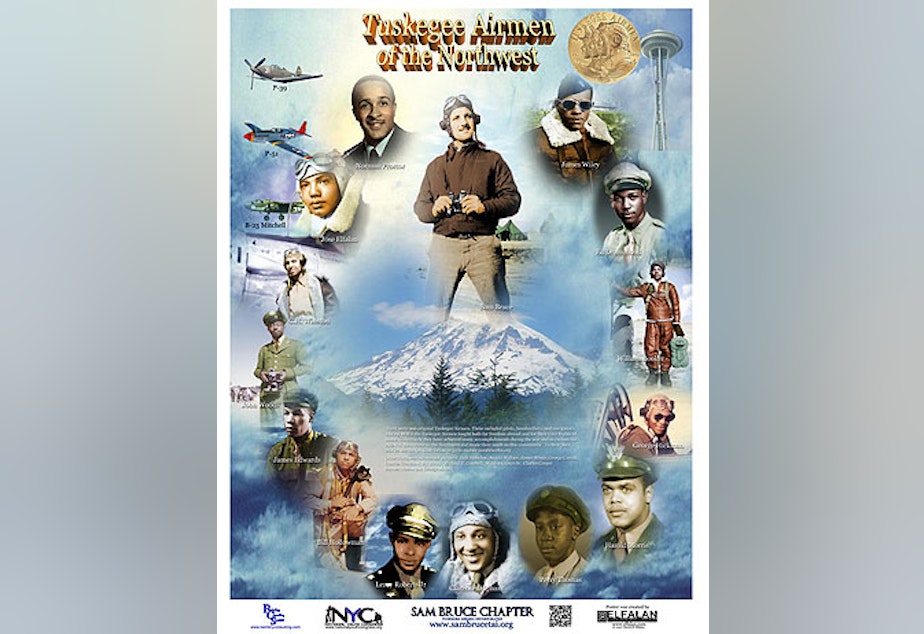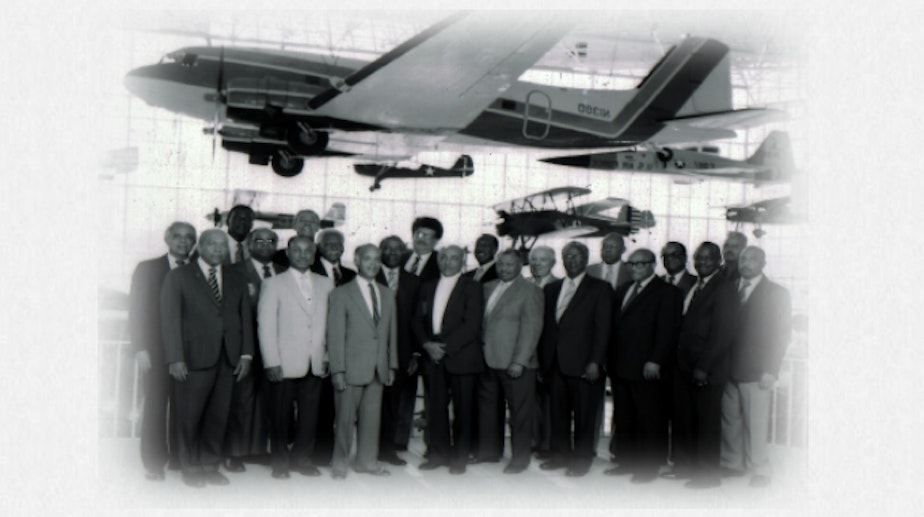Remembering the Tuskegee Airmen of the NW on the squad's 80th anniversary

The Tuskegee Airmen are some of the most well-known Black soldiers to serve in World War II, but we hear so little about the few who came from right here in the Northwest.
Thomas Gray is the recording secretary for the local Sam Bruce Chapter.
He wasn't a pilot himself, but when the retired Boeing engineer happened to go by one of their meetings decades ago, the airmen invited him to become a member.
Today, on this 80th anniversary of President Roosevelt activating the elite squadron, Thomas recalled some of the local men who were part of this U.S. and world history.
Thomas Gray: Well, I compiled a list recently. I also might mention that I am a docent at the Museum of Flight, and I compiled a list for the Tuskegee Airmen display. And I came up with a list of about 30 people that actually lived in the Northwest. Some of them were fliers, some with a support group. And a few of them also came to work for Boeing at the time when the pilots back from the war, a lot of them did not get jobs with the airlines. Boeing hired quite a few of the airmen.
Angela King: And for those who are familiar with the story of the Tuskegee Airmen, we know that they were the first Black military aviators in the U.S. Army Air Corps. They faced all kinds of discrimination. And some of the airmen from here were not allowed to fly overseas because of the Freeman Field mutiny, which happened in Kentucky. Can you tell us about that?
Gray: There was an incident where the Freeman Field fliers attempted to enter the white officers' club, and the fliers at the Freeman Field were actually arrested and put in a camp. And the group, they were actually behind barracks with barbed wire, and they could actually see the German prisoners of war that had been brought over to the United States were actually walking around outside their camp. So, the people that were fighting for their country were actually imprisoned, whereas the enemy prisoners of war had more freedom than American soldiers.

Sponsored
Angela King: Thomas, you're with the Sam Bruce Chapter of the Tuskegee Airmen. Who was Sam Bruce?
Gray: Sam Bruce was the only airman from the Seattle area to die in the war. He was actually a Garfield High School graduate, 1937 graduate of Garfield High School. He was quite athletic — he was on the basketball team, baseball, football teams — and he actually went to play football for UCLA one year and then eventually went to North Carolina [Agricultural and Technical State University]. And it was there that he heard about the Tuskegee program. And he lost his life, flying his [Curtiss] P-40 [Warhawk] before he at the Anzio beachhead invasion, and as a result, the chapter took on Sam Bruce's name.
Angela King: And his journey did not end with his death, because he was originally buried overseas, correct?
Gray: That's correct. He was buried in Italy. I was at a convention in Orlando, Florida, about four years ago. And I had told one of the people from the Department of Defense who searches for missing fliers, I told him that we didn't know what ever happened to Sam Bruce. And the next day, he came back with all the documentation that he had on Sam Bruce, including burial records that he had in Italy. And then, he showed me letters that they had, correspondence with his mother here in Seattle. And they asked whether she wanted to leave Sam Bruce buried in Italy or whether she would like for him to be brought back to Seattle. And in 1948, they actually brought Sam Bruce's remains back to Seattle.
Angela King: And there wasn't much fanfare with his return home. Why was that?
Sponsored
Gray: We don't know why. There was no indication of, at least, there seemed to be no indication in the local papers. He was buried in [Evergreen]Washelli [Memorial Park]. And when I first came to Seattle, I noticed there were some incidents where some question about whether Black people could be buried in certain cemeteries. And I wondered if, at the time, they did not want to be known that a Black man was being buried in Washelli or not. There is a marker that says Sam Bruce, 99th Fighter Squadron, and he did get buried in Seattle.
Angela King: And are there any local airmen still alive there?
Gray: None in the local area. We have one, one person was a founding member, Charles Cooper.
Angela King: And how old would he be now, approximately?
Gray: He would be, I'm sure, 96 or so.
Sponsored
Angela King: So was there any airman in particular you had a special relationship with? And if so, what is one of your favorite memories or stories they told you?
Gray: Well it was so, so many. I remember Ed Drummond, who lived in Tacoma. I remember him telling me about being at a convention in San Antonio. And he got on the elevator with [Major] Lemuel [Rodney] Custis, who happened to be in the first class [and who was the last surviving member of that first class headed by General Benjamin O. Davis Jr.]. And it just so happens that Ed Drummond was one of the last Tuskegee Airmen. And he commented, when he got on the elevator, that they were the first and the last on the same elevator.
Angela King: Wow. Well, you mention being one of the last. As their numbers dwindle, what do you want people to remember about these courageous men?
Gray: Well, I just like to hope that we maintain the legacy and people will continue to realize what part they played. Especially, in these trying times, that there were some people that came before us, and we hope that their legacy will continue to be observed.


